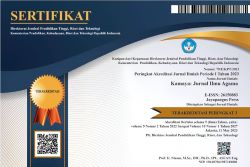Inkulturasi Dan Pemaknaan Misa Imlek Dalam Gereja Katolik
(Tinjauan Fenomenologi Armada Riyanto)
DOI:
https://doi.org/10.37329/kamaya.v6i1.2111Keywords:
Inculturation, Chinese New Year Meaning, Catholic Church, Mass, EucharistAbstract
The focus of this research is the Inculturation and meaning of Chinese New Year in the Catholic Church. The population of Indonesia consists of various tribes, religions and races. This shows the heterogeneity in Indonesia. Among the ethnic groups in Indonesia is the Chinese. In Chinese culture, the author discusses the meaning of thanksgiving for Chinese New Year celebrations. Thanksgiving is contained in the celebrations such as: the meaning of chinese new year mass in liturgy, the meaning of eating together, the meaning of chinese new year in the catholic church, and the church gives space; chinese new year inculturation. New year celebrations in China are symbolic rituals that adherents believe can bring blessings and happiness in the coming year. The purpose of the study was to determine the location of the inculturation of the celebration of Chinese New Year mass in the Catholic Church, understanding the meaning of inculturation and understanding of the celebration of Chinese New Year in the Eucharist. The findings in this research are contained in a framework that describes the reality of the meaning of the Inculturation of Chinese New Year Mass in the Catholic Church as a celebration of gratitude. The results of this study form the basis for the implementation of the Catholic Incutoration today. The author hopes to help, add human insight to Chinese New Year culture. The way of viewing and responding to an event spiritually has long existed and is part of the cultural tradition in Asia. So that Inculturation gives life to the Church filling and edifying with the light of faith, of Christ in the unity of Church tradition. This research is very relevant to today's situation, especially for the younger generation to get to know the various cultures that are integrated into the Church tradition as a unique and meaningful unity of faith.
References
Angelina, P. J., & Wardani, L. K. (2014). Makna Ruang Ritual dan Upacara pada Interior Keraton Surakarta. Intra, 2(2), 294–301.
Cassirer, E. (1987). Manusia dan Kebudayaan; Sebuah Esei Tentang Manusia.(diterjemahkan oleh Alois A Nugroho).
Dhavamony, M. (2010). Fenomenologi Agama. Yogyakarta: Kanisius.
Dillistone, F. W. (2002). The Power of Symbol (Daya Kekuatan Simbol). Yokyakarta: Kanisius. Penerjemah: A. Widyamartaya.
F. Danuwinata, N. Dister, & I.R. Poedjawijatna (Ed.). (1977). Dari Sudut-Sudut Filsafat: Sebuah Bunga Rampai. Yogyakarta: Kanisius.
Fachraddiena, A. Inkulturasi Misa Syukur Tahun Baru Imlek Gereja Katolik Santo Barnabas Pamulang (Bachelor's thesis, Jakarta: Fakultas Ushuluddin Dan Filsafat UIN Syarif Hidayatullah).
Gunawan, E. (2014). Menuju Liturgi yang Kontekstual: Suatu Tinjauan terhadap Liturgi Gereja-Gereja Tionghoa Indonesia.
Hairiyah, H. (2022, Juli 27). Makna Tradisi Perayaan Imlek Di Klenteng Soetji Nurani Banjarmasin.
Indahwati, S., & Christiana, E. (2017). Semangat Hakka yang Dicerminkan oleh Orang Hakka melalui Kegiatan Merayakan Imlek. Century: Journal of Chinese Language, Literature and Culture, 5(1), 1-9.
Komisi Liturgi MAWI. (1985). Bina Liturgia I: Inkulturasi. Jakarta: Obor.
Langer, S. K. (2009). Philosophy in A New Key: A Study In The Symbolism of Reason, Rite, and Art. Londin: Harvad University Press.
Lembong, E. (2008). Indonesian government policies and the ethnic Chinese: Some recent developments. Ethnic Chinese in Contemporary Indonesia, Singapore: Institute of Southeast Asian Studies, 48.
Martasudjita, E. (1998). Memahami Simbol-simbol Dalam Liturgi: Dasar Teologi Liturgis, Makna Simbol, Pakaian, Warna, Ruang, Tahun, dan Musik Liturgi. Yogyakarta: Kanisius.
Martasudjita, E. (2005). Ekaristi: Tinjauan Teologis, Liturgis, dan Pastoral. Yogyakarta: Kanisius.
Paul, V. I., DIEU, S. D., & ... (1963). Sacrosanctum concilium. paroisseportet.
Rahayu, P. P., & Indiarti, P. T. (2020). Makna Peruntungan Usaha dalam Simbol di Budaya Imlek bagi Masyarakat Etnis Tionghoa Surabaya. Jurnal Psikologi Perseptual, 5(1), 55.
Riyanto, A. (2018). Relasionalitas Filsafat Fondasi Interpretasi: Aku, Teks, Liyan, Fenomen. Yogyakarta: Kanisius.
Rudyansjah, T., Damm, M., Solihat, A., Riyanto, G., & ... (2012). Antropologi Agama: Wacana-Wacana Mutakhir dalam Kajian Religi dan Budaya. Jakarta: UI Press.
Sastrapratedja, M. (1982). Manusia Multi Dimensional: Sebuah Renungan Filsafat. Jakarta: PT. Gramedia.
Simatupang, W. P. (2019). AGAMA DAN SENI (Studi Pemanfaatan Seni pada Liturgi Ekaristi di Gereja Katolik St. Athanasius Agung, Karangpanas, Semarang) (Doctoral dissertation, Fakultas Ilmu Budaya).
Tambunan, J. B., Hutauruk, S., & Pardede, Z. H. S. (2017). Mitos Tradisi Perayaan Tahun Baru Imlek. PANTUN: Jurnal Ilmiah Seni Budaya, 2(2).
Wauran, K. J., Lamadirisi, M., & Singal, Z. H. (2020). Tradisi perayaan imlek pada masyarakat etnis tionghoa di kota manado. Jurnal paradigma: Journal of Sociology Research and Education, 1(2), 42-45.
Winarta, F. H. (2008). No more discrimination against the Chinese. Ethnic Chinese in Contemporary Indonesia, 57-74.
Yuanzhi, K., & Zhiqiong, X. (2005). Silang Budaya Tiongkok-Indonesia. Jakarta: Bhuana Ilmu Populer.
Downloads
Published
How to Cite
Issue
Section
License
Copyright (c) 2023 Kamaya: Jurnal Ilmu Agama

This work is licensed under a Creative Commons Attribution-ShareAlike 4.0 International License.
An author who publishes in the Kamaya : Jurnal Ilmu Agama agrees to the following terms:
- Author retains the copyright and grants the journal the right of first publication of the work simultaneously licensed under the Creative Commons Attribution-ShareAlike 4.0 License that allows others to share the work with an acknowledgement of the work's authorship and initial publication in this journal
- Author is able to enter into separate, additional contractual arrangements for the non-exclusive distribution of the journal's published version of the work (e.g., post it to an institutional repository or publish it in a book) with the acknowledgement of its initial publication in this journal.
- Author is permitted and encouraged to post his/her work online (e.g., in institutional repositories or on their website) prior to and during the submission process, as it can lead to productive exchanges, as well as earlier and greater citation of the published work (See The Effect of Open Access).
Read more about the Creative Commons Attribution-ShareAlike 4.0 Licence here: https://creativecommons.org/licenses/by-sa/4.0/.





